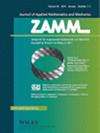Frequency stability analysis of a cantilever viscoelastic CNT conveying fluid on a viscoelastic Pasternak foundation and under axial load based on nonlocal elasticity theory
IF 3.2
4区 工程技术
Q1 MATHEMATICS, APPLIED
Zamm-zeitschrift Fur Angewandte Mathematik Und Mechanik
Pub Date : 2023-09-02
DOI:10.1002/zamm.202100536
引用次数: 0
Abstract
In this paper, the frequency stability analysis of a fluid conveying cantilever viscoelastic carbon nanotube (CNT) in the Kelvin–Voigt material model with slip boundary condition (BC) regime on a viscoelastic Pasternak foundation and under axial load has been performed based on nonlocal Euler–Bernoulli thin beam theory. The governing partial differential equation of motion (EOM) and its associated BCs have been derived using the Hamilton principle. The governing EOM has been converted into an ordinary differential equation using mode summation technique and solved by applying the extended Galerkin method. Then, the frequency stability analysis has been carried out for the vibrational response of CNT in the state‐space form. The obtained results have been validated with the literature works. The effect of changes of various parameters like elastic stiffness, shear stiffness and damping coefficients of foundation, nonlocal scale‐effect parameter of the nanotube, fluid flow Knudsen number, mass ratio, structural damping of the nanotube and applied axial force have been investigated in terms of frequency to predict the occurrence of different instability modes for the system. It is concluded that flutter and divergence instabilities in the vibration of the viscoelastic CNT are significantly affected by changes of different above‐mentioned parameters.基于非局部弹性理论的粘弹性CNT在粘弹性帕斯捷尔纳克地基和轴向载荷作用下悬臂式粘弹性CNT输液频率稳定性分析
本文基于非局部Euler-Bernoulli薄梁理论,对粘弹性Pasternak地基上具有滑移边界条件(BC)的Kelvin-Voigt材料模型中输液悬臂粘弹性碳纳米管(CNT)在轴向载荷作用下的频率稳定性进行了分析。利用哈密顿原理推导了运动的控制偏微分方程(EOM)及其相关的微分方程。利用模态和技术将控制方程转化为常微分方程,并采用扩展伽辽金法求解。然后,对碳纳米管在状态空间形式下的振动响应进行了频率稳定性分析。所得结果已与文献资料进行了验证。研究了基础弹性刚度、剪切刚度和阻尼系数、纳米管非局部尺度效应参数、流体流动Knudsen数、质量比、纳米管结构阻尼和施加轴向力等参数变化对系统发生不同失稳模式的影响。结果表明,上述不同参数的变化对粘弹性碳纳米管振动中的颤振和散度失稳有显著影响。
本文章由计算机程序翻译,如有差异,请以英文原文为准。
求助全文
约1分钟内获得全文
求助全文
来源期刊
CiteScore
3.30
自引率
8.70%
发文量
199
审稿时长
3.0 months
期刊介绍:
ZAMM is one of the oldest journals in the field of applied mathematics and mechanics and is read by scientists all over the world. The aim and scope of ZAMM is the publication of new results and review articles and information on applied mathematics (mainly numerical mathematics and various applications of analysis, in particular numerical aspects of differential and integral equations), on the entire field of theoretical and applied mechanics (solid mechanics, fluid mechanics, thermodynamics). ZAMM is also open to essential contributions on mathematics in industrial applications.

 求助内容:
求助内容: 应助结果提醒方式:
应助结果提醒方式:


